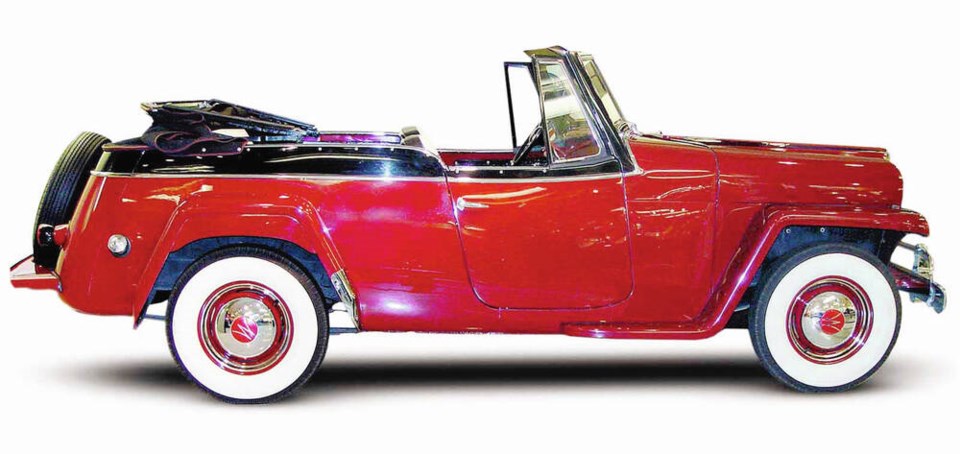In the 1990s, you couldn’t throw a Frisbee in suburbia without hitting a Ford Explorer, Chevy Blazer or a Jeep Cherokee sport-utility vehicle. The Willys-Overland Motor Company can take credit for at least some of that popularity.
At the end of the Second World War in 1945, most automakers focused on returning their factories to their original function of making cars and trucks for the public, instead of supporting the war effort by churning out weapons.
That conversion process presented both a challenge and an opportunity for Willys-Overland, the primary producer of the legendary Jeep.
The Toledo, Ohio-based company had assembled more than 361,000 of those go-anywhere four-wheel-drive personnel carriers from 1941-’45, and plans were made to produce a civilian version with a few modifications such as a flip-down tailgate and bigger headlights.
While production of the C2A (“C” for civilian) Jeep ramped up, Willys decided to further capitalize on the popular Jeep brand by introducing a range of vehicles that could directly compete with General Motors, Ford and Chrysler.
The first such creation was the Jeep Station Wagon, penned by famed industrial designer/inventor Brooks Stevens, that featured a stylized Jeep grille that fronted a boxy all-steel enclosed body. In fact, it was the first station wagon to be built without the traditional wood-ribbed panels that were a fixture on competing models (although a faux wood-style paint scheme was available as an option).
The Station Wagon, originally available in rear-wheel-drive only, was launched in 1946 and was quickly followed by a panel delivery and two- and four-wheel-drive pickup versions a year later. All models were eventually offered with a four-cylinder or optional six-cylinder powerplant with up to 72 horsepower on tap.
Creature comforts were few and far between in the Station Wagon. The primary selling features for this Jeep were its easily removable rear and front passenger seats (to increase load space) plus the fact that owners could hose out the painted metal floors when the need arose. Finally, with two to three feet less overall length than that of a typical sedan, the Station Wagon was a nimble and easy-to-park hauler.
The vehicle remained in continuous production until 1965, long after Willys-Overland had surrendered ownership of the company to Kaiser Industries, with only modest power increases and minor trim changes to report. Their replacements, the Cherokee and Wagoneer, also designed by Stevens, would last another 30 years.
The Station Wagon’s practical nature ran counter to the launch of the Jeepster in 1948, easily one of the more controversial (some would claim outlandish) vehicles to ever make it into production. The Jeepster also flowed from Stevens’ fertile mind and his flamboyant sales skills were likely used to convince Willys management that the vehicle would be a sure-fire hit.
As with the Station Wagon, the Jeepster had a traditional-looking Jeep grille set between two large, round headlights, but from there on back, all the body panels were unique. The interior was also downright luxurious by Jeep standards and, from behind the wheel, it could have easily be mistaken for a more mainstream automobile. There were floor mats, leather seats, a large chrome-ringed steering wheel and a tonneau cover that hid the mechanically folding top.
On the minus sheet, roll-up windows were not available and buyers were forced to install a set of side curtains when the weather turned nasty.
First-year Jeepsters came with decidedly non-sporting 63-horsepower four-cylinder engines, but the six-cylinder engine developed for the Station Wagon was optional the following year.
Unfortunately for Willys, the Jeepster proved to be long on whimsy and short on practicality. Following a reasonably successful initial year, sales fell well short of expectations as the Big Three’s new post-war models began to arrive. As well, development of both the Station Wagon and the Jeepster seemed to delay the start of Willys-Overland’s new passenger-car line that didn’t appear until 1952, long after the Jeepster experiment was shut down.
Surprisingly, Kaiser saw fit to bring back a restyled Jeepster (called the Jeepster Commando) for 1966 and American Motors kept the marque going for what would be its final three years after acquiring the Jeep brand in 1970.
For Jeep’s foray into the mainstream, practical clearly won out over fanciful, a hard-won lesson that remains as true today as it proved to be more than seven decades ago.
Malcolm Gunn is a feature writer with Wheelbase Media. He can be reached on the web at theoctanelounge.com by clicking the contact link. Wheelbase supplies automotive news and features to newspapers across North America.



